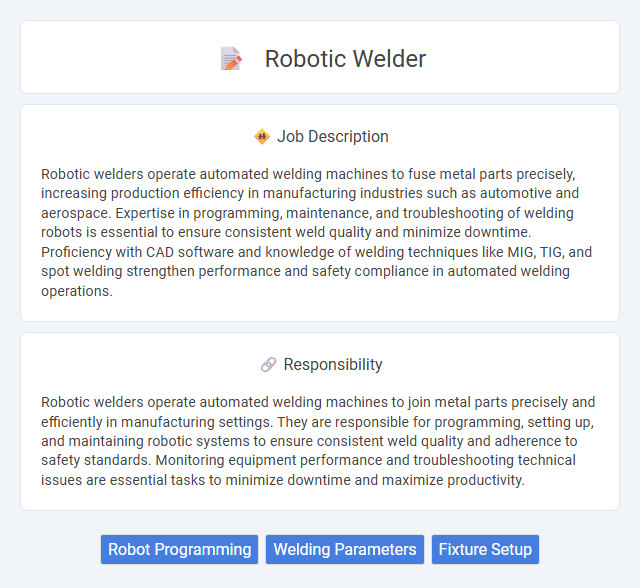
Robotic welders operate automated welding machines to fuse metal parts precisely, increasing production efficiency in manufacturing industries such as automotive and aerospace. Expertise in programming, maintenance, and troubleshooting of welding robots is essential to ensure consistent weld quality and minimize downtime. Proficiency with CAD software and knowledge of welding techniques like MIG, TIG, and spot welding strengthen performance and safety compliance in automated welding operations.
People with strong technical skills and good hand-eye coordination are likely to be well-suited for a robotic welder job, as the role often requires programming and operating automated welding machines. Individuals who prefer precise, repetitive tasks and can maintain focus in potentially noisy and industrial environments may find this job suitable. However, those who are uncomfortable with machinery or have difficulty adapting to technological tools might face challenges in this field.
Qualification
Robotic welders require specialized training in robotic welding technology, typically obtained through certification programs or vocational courses in welding and automation. Proficiency in programming, operating, and maintaining robotic welding systems, combined with knowledge of metallurgy and welding safety standards, is essential for effectiveness. Strong problem-solving skills and experience with CAD/CAM software enhance a robotic welder's capability to optimize weld quality and production efficiency.
Responsibility
Robotic welders operate automated welding machines to join metal parts precisely and efficiently in manufacturing settings. They are responsible for programming, setting up, and maintaining robotic systems to ensure consistent weld quality and adherence to safety standards. Monitoring equipment performance and troubleshooting technical issues are essential tasks to minimize downtime and maximize productivity.
Benefit
Robotic welder jobs likely offer increased productivity by automating repetitive welding tasks, leading to consistent and high-quality welds. This automation probably reduces worker fatigue and exposure to hazardous environments, enhancing safety on the job site. Operators may also experience career growth opportunities by developing specialized skills in programming and maintaining advanced welding robots.
Challenge
Robotic welder jobs likely present significant challenges due to the need for precise programming and troubleshooting of complex machinery. Skilled operators must probably adapt quickly to evolving technologies and maintain high accuracy under time constraints. The position may require continuous learning to manage software updates and hardware integration effectively.
Career Advancement
Robotic welder careers offer significant opportunities for advancement, with professionals advancing from entry-level machine operators to programming and maintenance specialists. Mastery of robotic welding technologies and proficiency in automation software enhance prospects for supervisory or engineering roles. Continuous training in cutting-edge robotic systems and safety standards is critical for climbing the career ladder in advanced manufacturing sectors.
Key Terms
Robot Programming
Robotic welder jobs require expertise in robot programming to efficiently control automated welding machines for precision and consistency. Proficiency in programming languages such as RAPID, KRL, or FANUC is essential to configure robotic arms for various welding tasks and optimize production workflows. Strong knowledge of sensor integration, motion control, and troubleshooting robotic systems enhances weld quality and minimizes downtime in manufacturing environments.
Welding Parameters
Robotic welders rely on precise welding parameters such as voltage, current, wire feed speed, and travel speed to ensure consistent, high-quality welds. Accurate control of these parameters optimizes bead shape, penetration, and minimizes defects like porosity and spatter. Advanced robotic welding systems integrate sensor feedback and programmable logic controllers (PLCs) to dynamically adjust parameters for varying material types and thicknesses.
Fixture Setup
Robotic welder fixture setup involves precisely positioning and securing metal components to ensure accuracy and stability during automated welding processes. Proper fixture setup reduces welding defects, increases production efficiency, and enhances the consistency of welded joints. Expertise in interpreting engineering drawings and using alignment tools is critical for optimizing robotic welding operations and minimizing downtime.
 kuljobs.com
kuljobs.com